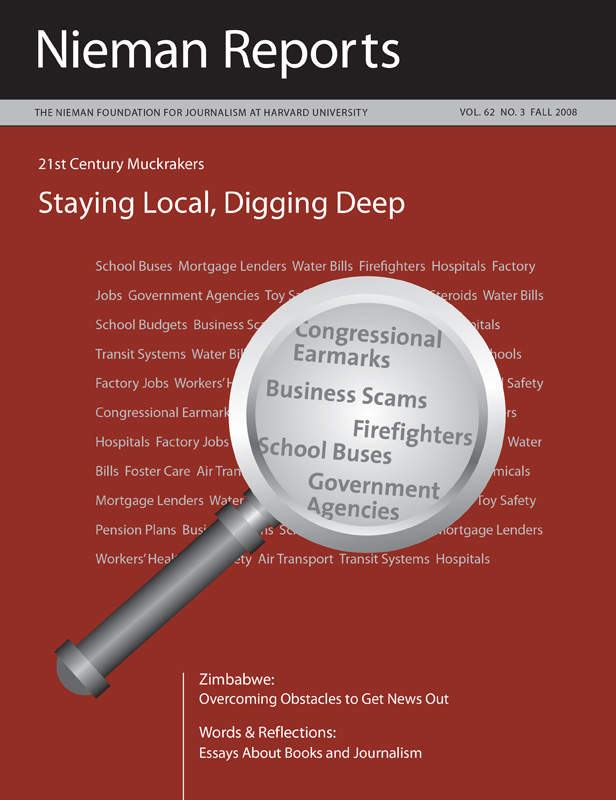
21st Century Muckrakers: Staying Local, Digging Deep
On this point, editors, reporters and newspaper readers agree. In a time of cutbacks and a shrinking news hole, at a moment when print is in peril and digital is dominant, watchdog and investigative reporting must remain at the core of journalism’s mission. In this third part of our 21st Century Muckrakers project, editors and reporters speak to how metro and regional newspapers are confronting the enormous challenges of today and offer clues to where this kind of reporting will likely be headed tomorrow.
During a July 28th conference call about A.H. Belo’s sharply declining earnings (a 15 percent decline in the second quarter) and the impending round of 500 staff layoffs at its three daily newspapers, Goldman Sachs analyst Peter Appert asked Belo CEO Robert Decherd what he called an “impossible question,” according to Rick Edmonds, who reported this on the Poynter Institute’s Biz Blog. The question Appert posed is precisely the one that many newspaper owners, publishers and editors are asking themselves at a time of accelerating and deep staff cuts, with reductions in the news hole, and with the multilayered challenges they face in meeting the demands of the digital audience.
“How do you maintain editorial relevance and quality as you are doing such dramatic cuts in staff?” Appert wanted to know.
Decherd’s response, like Appert’s question, echoes through the corridors of many news organizations. While acknowledging fairly substantial changes in newsroom operations, Decherd would not concede that the Belo relevance—as conveyors of news and information in their communities—would suffer, even as the number of those available to do reporting and the financial resources to support their work continues to decrease.
Variations on this equation—pairing the known losses of input with rosy predictions of stability for the output—have gained a foothold in newspaper newsrooms. Each time more layoffs are announced, this notion rises as the mantra of those left behind. Rarely do newsroom leaders respond to cutbacks by acknowledging that fewer resources + fewer reporters + fewer photographers + fewer editors will likely result in a less appealing product for consumers. And when it comes to investigative reporting, what is required is the patience of editors, the persistence of reporters, and the deep pocketbooks and legal protection of publishers, all things that surely get depleted as newsrooms shrink.
All of this was acknowledged by none other than Google CEO Eric Schmidt, who in July at the Ad Age Madison + Vine Conference in Beverly Hills, California, wondered aloud about whether and how investigative reporting will survive as its platform shifts from print to digital media. His reasoning: the great difficulty being had in finding viable financial models to support the work of those who do this kind of labor-intensive reporting.
In this issue—our third in a year-long, four-part project exploring various aspects of the changing journalistic landscape for investigative reporting—editors and reporters from midsized newspapers with a proven reputation for investigative journalism speak of their evolving approaches to doing this kind of work. From the standpoint of readers, finding new strategies to keep investigative reporting alive and well is critical to retaining them. Ask people for ideas on what content news organizations should emphasize in this era of staff cuts, as The Miami Herald recently did, and the response is summed up well by the words one reader wrote: “What is most important to me is that the Herald survives to blow the whistle, investigate, create a community dialogue. You’re the only watchdog left.”
“How do you maintain editorial relevance and quality as you are doing such dramatic cuts in staff?” Appert wanted to know.
Decherd’s response, like Appert’s question, echoes through the corridors of many news organizations. While acknowledging fairly substantial changes in newsroom operations, Decherd would not concede that the Belo relevance—as conveyors of news and information in their communities—would suffer, even as the number of those available to do reporting and the financial resources to support their work continues to decrease.
Variations on this equation—pairing the known losses of input with rosy predictions of stability for the output—have gained a foothold in newspaper newsrooms. Each time more layoffs are announced, this notion rises as the mantra of those left behind. Rarely do newsroom leaders respond to cutbacks by acknowledging that fewer resources + fewer reporters + fewer photographers + fewer editors will likely result in a less appealing product for consumers. And when it comes to investigative reporting, what is required is the patience of editors, the persistence of reporters, and the deep pocketbooks and legal protection of publishers, all things that surely get depleted as newsrooms shrink.
All of this was acknowledged by none other than Google CEO Eric Schmidt, who in July at the Ad Age Madison + Vine Conference in Beverly Hills, California, wondered aloud about whether and how investigative reporting will survive as its platform shifts from print to digital media. His reasoning: the great difficulty being had in finding viable financial models to support the work of those who do this kind of labor-intensive reporting.
In this issue—our third in a year-long, four-part project exploring various aspects of the changing journalistic landscape for investigative reporting—editors and reporters from midsized newspapers with a proven reputation for investigative journalism speak of their evolving approaches to doing this kind of work. From the standpoint of readers, finding new strategies to keep investigative reporting alive and well is critical to retaining them. Ask people for ideas on what content news organizations should emphasize in this era of staff cuts, as The Miami Herald recently did, and the response is summed up well by the words one reader wrote: “What is most important to me is that the Herald survives to blow the whistle, investigate, create a community dialogue. You’re the only watchdog left.”